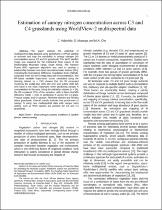 ResearchSpace
ResearchSpace
Estimation of canopy nitrogen concentration across C3 and C4 grasslands using WorldView-2 multispectral data
JavaScript is disabled for your browser. Some features of this site may not work without it.
- ResearchSpace
- →
- Research Publications/Outputs
- →
- Journal Articles
- →
- View Item
| dc.contributor.author |
Adjorlolo, C

|
|
| dc.contributor.author |
Mutanga, O

|
|
| dc.contributor.author |
Cho, Moses A

|
|
| dc.date.accessioned | 2015-03-12T09:27:14Z | |
| dc.date.available | 2015-03-12T09:27:14Z | |
| dc.date.issued | 2014-05 | |
| dc.identifier.citation | Adjorlolo, C., Mutanga, O. and Cho M.A. 2014. Estimation of canopy nitrogen concentration across C3 and C4 grasslands using WorldView-2 multispectral data. IEEE Journal of Selected Topics in Applied Earth Observations and Remote Sensing, pp 286 - 291 | en_US |
| dc.identifier.issn | 1939-1404 | |
| dc.identifier.uri | http://ieeexplore.ieee.org/xpls/abs_all.jsp?arnumber=6815643&tag=1 | |
| dc.identifier.uri | http://hdl.handle.net/10204/7881 | |
| dc.description | Copyright: 2014 IEEE. This is a post-print version. The definitive version of the work is published in IEEE Journal of Selected Topics in Applied Earth Observations and Remote Sensing, pp 286 - 291 | en_US |
| dc.description.abstract | This paper assesses the potential of multispectral data attained using WorldView-2 (WV2) satellite to estimate and map the variability in canopy nitrogen (N) concentration across C3 and C4 grasslands. The WV2 satellite image was acquired for the Cathedral Peak region of the Drakensberg Mountain range, South Africa. The Random Forest (RF) regression algorithm was used to develop a relationship between two-band normalized ratio indices (RIs), including the Normalized Difference Vegetation Index (NDVI), computed from the WV2 image data and N concentration. The RF-based variable importance scores calculated using the training dataset (n = 150) showed that the RI computed involving the costal-blue (400–450 nm) and yellow (585–625 nm) band is the most important, when predicting canopy N concentration in the area. Using the validation dataset (n = 64), the RF explained 71% of the variation, with a Nash–Sutcliffe efficiency (NSE) = 0.68, in predicting N across the C3 grass, Festuca costata, and C4 grasses, Themeda triandra and Rendlia altera grasslands. Overall, results indicate that predictions of canopy N using new multispectral data with unique band setting, such as WV2 spectra are possible for C3 and C4 grasslands. | en_US |
| dc.language.iso | en | en_US |
| dc.publisher | IEEE | en_US |
| dc.relation.ispartofseries | Workflow;14258 | |
| dc.subject | Grass nitrogen content | en_US |
| dc.subject | Random forests | en_US |
| dc.subject | Remote sensing | en_US |
| dc.subject | Worldview-2 | en_US |
| dc.title | Estimation of canopy nitrogen concentration across C3 and C4 grasslands using WorldView-2 multispectral data | en_US |
| dc.type | Article | en_US |
| dc.identifier.apacitation | Adjorlolo, C., Mutanga, O., & Cho, M. A. (2014). Estimation of canopy nitrogen concentration across C3 and C4 grasslands using WorldView-2 multispectral data. http://hdl.handle.net/10204/7881 | en_ZA |
| dc.identifier.chicagocitation | Adjorlolo, C, O Mutanga, and Moses A Cho "Estimation of canopy nitrogen concentration across C3 and C4 grasslands using WorldView-2 multispectral data." (2014) http://hdl.handle.net/10204/7881 | en_ZA |
| dc.identifier.vancouvercitation | Adjorlolo C, Mutanga O, Cho MA. Estimation of canopy nitrogen concentration across C3 and C4 grasslands using WorldView-2 multispectral data. 2014; http://hdl.handle.net/10204/7881. | en_ZA |
| dc.identifier.ris | TY - Article AU - Adjorlolo, C AU - Mutanga, O AU - Cho, Moses A AB - This paper assesses the potential of multispectral data attained using WorldView-2 (WV2) satellite to estimate and map the variability in canopy nitrogen (N) concentration across C3 and C4 grasslands. The WV2 satellite image was acquired for the Cathedral Peak region of the Drakensberg Mountain range, South Africa. The Random Forest (RF) regression algorithm was used to develop a relationship between two-band normalized ratio indices (RIs), including the Normalized Difference Vegetation Index (NDVI), computed from the WV2 image data and N concentration. The RF-based variable importance scores calculated using the training dataset (n = 150) showed that the RI computed involving the costal-blue (400–450 nm) and yellow (585–625 nm) band is the most important, when predicting canopy N concentration in the area. Using the validation dataset (n = 64), the RF explained 71% of the variation, with a Nash–Sutcliffe efficiency (NSE) = 0.68, in predicting N across the C3 grass, Festuca costata, and C4 grasses, Themeda triandra and Rendlia altera grasslands. Overall, results indicate that predictions of canopy N using new multispectral data with unique band setting, such as WV2 spectra are possible for C3 and C4 grasslands. DA - 2014-05 DB - ResearchSpace DP - CSIR KW - Grass nitrogen content KW - Random forests KW - Remote sensing KW - Worldview-2 LK - https://researchspace.csir.co.za PY - 2014 SM - 1939-1404 T1 - Estimation of canopy nitrogen concentration across C3 and C4 grasslands using WorldView-2 multispectral data TI - Estimation of canopy nitrogen concentration across C3 and C4 grasslands using WorldView-2 multispectral data UR - http://hdl.handle.net/10204/7881 ER - | en_ZA |





